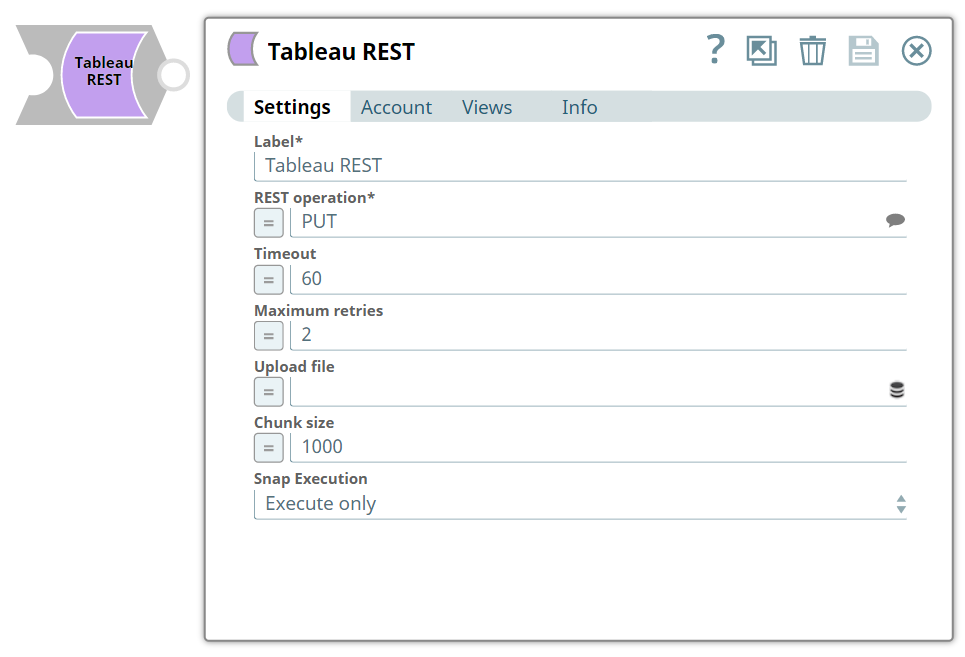Tableau REST
Overview
You can use this Snap to invoke Tableau's REST API.

Write-type Snap
Works in Ultra Tasks
Prerequisites
None.
Limitations
- Supports Tableau 10.5.
- To publish hyper files without packaging them as a data source, the file must contain exactly one schema in one table.
Snap views
| View | Description | Examples of upstream and downstream Snaps |
|---|---|---|
| Input | Data in document format. | |
| Output | REST output sent to the output view with Tableau REST XML (for example, Headers and REST Status line) with response entity converted from XML to JSON. | Examples: |
| Error |
Error handling is a generic way to handle errors without losing data or failing the Snap execution. You can handle the errors that the Snap might encounter when running the pipeline by choosing one of the following options from the When errors occur list under the Views tab. The available options are:
Learn more about Error handling in Pipelines. |
|
Snap settings
- Expression icon (
): Allows using JavaScript syntax to access SnapLogic Expressions to set field values dynamically (if enabled). If disabled, you can provide a static value. Learn more.
- SnapGPT (
): Generates SnapLogic Expressions based on natural language using SnapGPT. Learn more.
- Suggestion icon (
): Populates a list of values dynamically based on your Snap configuration. You can select only one attribute at a time using the icon. Type into the field if it supports a comma-separated list of values.
- Upload
 : Uploads files. Learn more.
: Uploads files. Learn more.
| Field / Field set | Type | Description |
|---|---|---|
| Label | String | Required. Specify a unique name for the Snap. Modify this to be more appropriate, especially if there are more than one of the same Snap in the pipeline. |
| REST operation | String/Expression |
Required. Specify or select the Tableau REST operation to perform. For a list of Tableau REST operations, see the Tableau API Reference documentation. Default value: N/A Example: publish_datasource |
| Timeout | Integer/Expression |
Specify the timeout for HTTP in seconds.
Default value: 60 Example: 90 |
| Maximum retries | Integer/Expression |
Specify the maximum number of HTTP request retries.
Default value: 2 Example: 10 |
| Upload file | String/Expression |
Specify the path of the file that you want to upload.
Note:
Important: Used only for publish datasource and publish workbook REST operations to write data into Tableau.
Default value: N/A Example: date.txt |
| Chunk size | Integer/Expression |
Specify the chunk size (in kilobytes) to upload. Specify 0 if you do not want chunking mechanism to be used during upload/publish.
Note:
This field only applies to publishing Tableau workbooks or Tableau datasources operations with an upload file defined.
This is a recommended setting for large files and is mandatory for file sizes greater than 64 MB.
Default value: 1000 Example: 2000 |
| Snap execution | Dropdown list | Choose one of the three modes in which the Snap executes. Available options
are:
|
Behavior Change
In the 4.23 release, the Tableau REST Snap had a defect where it used site ID and user ID from the Tableau Account even if the selected REST operation required a site ID and/or user ID from the input document. This issue is fixed in the 4.24 release, so that the Snap uses values for the said IDs from the input document when available. Since this fix changes the Snap behavior, it is possible for production Pipelines to fail after the 4.24 release. Hence, you need to reconfigure the Tableau REST Snap using the site ID and user ID values from the input document.
Troubleshooting
- Start new development with more simpler REST operations like query sites before troubleshooting more complex REST operations like publish datasource.
- You may wish to use a second tool (For example,
curl) for independent verification of Tableau Server configuration. - Tableau uses ID with GUID like values as opposed to worded names for input parameters. For example, SiteID is used instead of Site Name.


